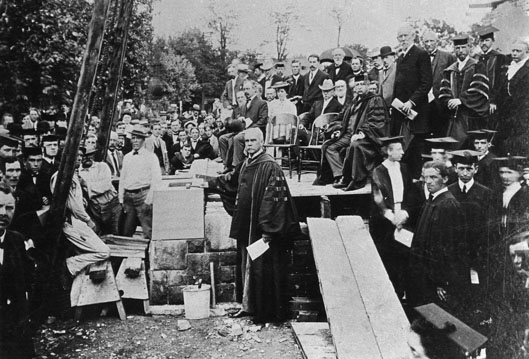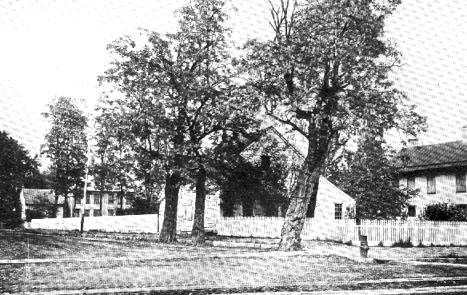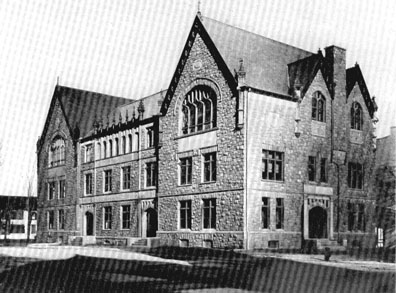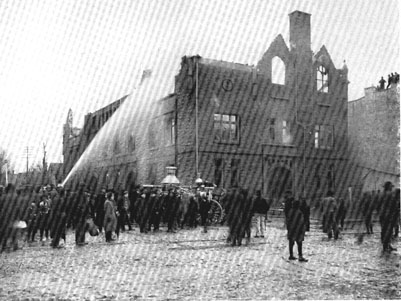
The Denny Cornerstone 1904

George Edward Reed, who is seen in the middle of the photograph, was elected President of Dickinson College January 3, 1889. He entered the presidency at a time when the enrollment of the college was quite low. Reed was born in Maine in 1846 and graduated from Wesleyan University in 1869. He was a very popular president, especially with the students. Reed was an eloquent speaker who preached all over the community. Almost immediately after Reed became president he reestablished the Law School in 1890. Reed worked quite hard at increasing the enrollment and in only five years he had doubled the numbers at the College. Because the population of students at Dickinson was increasing so quickly, the College needed more space and buildings. Students expressed to Reed that the facilities at the College were becoming quite crowded and since Reed felt that the surroundings of the students had a great influence on them, he decided to acquire more property for the College (Morgan, 362-65).
Across West Street from the college campus was an estate owned by the Denny family. The "Pleasant View" estate, as it was called, dated back to the Denny family since 1814. The name goes all the way back to David Denny who graduated Dickinson College in 1788. David's niece, Priscilla, was the first Denny to own this property. The land was willed to her in 1814 by her husband Simon Boyd. Priscilla later sold the estate to her nephew, Harmer Denny, who had graduated from Dickinson in 1813. The estate would later be acquired by Harmer's daughter Matilda. (DCA, DF, Denny I)
![]()

At the time of Reed's administration, Miss Matilda Wilkens Denny, who had now moved on to Pittsburgh, was still the owner of the "Pleasant View" estate. Reed felt that property would be quite suitable for the college, but Miss Matilda had informed him that the land was absolutely not for sale. The land had quite a history within the Denny family and Miss Matilda would not easily part with it. Supposedly, President George Washington had hitched his horse to a tree on the "Pleasant View" estate while he was in Carlisle to suppress the "Whiskey Insurrection." People had tried to buy the land from the Denny's before, but the family simply would not sell. Reed took a different approach at acquiring the land. He told Miss Matilda that he was not interested in buying the land at all, Reed wanted her to donate the land. In recognition of the donation Reed offered to name the building he wished to build on the land as the "Denny Memorial Building." Miss Matilda then not only donated the land, but along with her relative Mrs. O'Hara Denny Spring, donated $12,000 towards the building's construction. (Dickinson Alumnus, Nov. 1926).
On June 8, 1896 the first Denny Memorial Building was completed under
the architect Thomas P. Lonsdale at a cost of $40,000 (Sellers, 584).
The Denny Memorial Building was in use for eight years until March 4, 1904,
when a fire broke out in the building due to a defect in the electrical
wiring. The building was burned almost completely down to the ground,
as the photographs directly below show. After the fire Reed proclaimed
that the building would rise again (Dickinson Alumnus, Nov.1926).
 |
 |
A few months after the fire, on June 7, President Reed laid the cornerstone
for the new Denny Memorial Building as seen in the photograph at the top
of the page. A year later, June 6, 1905, the new building was resurrected
by the architectural company of Miller I. Kast at the cost of $62, 964.84.
(Sellers, 584). The new building is made of Hummelstown brownstones
on the first story and the second and third stories made of dark iron clay
pressed brick secured in Ohio (Dickinson College Catalogue, 1900-05).
The new Denny building is one third larger than the old building and includes
an added tower to the building thanks to a $2,500 donation made by
Mr. William C. Allison. The "Lenore Allison Tower" is named his wife
and now houses the College bell. The Denny building is still standing and
in use to this day at Dickinson College after undergoing a almost complete
internal renovation during the mid 1980's. In fact, this essay was
typed in this building.